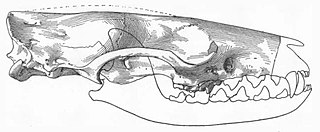
The Green River Formation is an Eocene geologic formation that records the sedimentation in a group of intermountain lakes in three basins along the present-day Green River in Colorado, Wyoming, and Utah. The sediments are deposited in very fine layers, a dark layer during the growing season and a light-hue inorganic layer in the dry season. Each pair of layers is called a varve and represents one year. The sediments of the Green River Formation present a continuous record of six million years. The mean thickness of a varve here is 0.18 mm, with a minimum thickness of 0.014 mm and maximum of 9.8 mm.

Viverravidae is an extinct monophyletic family of mammals from extinct superfamily Viverravoidea within the clade Carnivoramorpha, that lived from the early Palaeocene to the late Eocene in North America, Europe and Asia. They were once thought to be the earliest carnivorans and ancestral to extant ones, but now are placed outside the order Carnivora based on cranial morphology as relatives to extant carnivorans.

Miacis is an extinct genus of placental mammals from clade Carnivoraformes, that lived in North America from early to middle Eocene.

Oxyaena is an extinct genus of placental mammals from extinct subfamily Oxyaeninae within extinct family Oxyaenidae, that lived in Europe, Asia and North America during the early Eocene.

The Fort Union Formation is a geologic unit containing sandstones, shales, and coal beds in Wyoming, Montana, and parts of adjacent states. In the Powder River Basin, it contains important economic deposits of coal, uranium, and coalbed methane.

Remingtonocetus is an extinct genus of early cetacean freshwater aquatic mammals of the family Remingtonocetidae endemic to the coastline of the ancient Tethys Ocean during the Eocene. It was named after naturalist Remington Kellogg.

Vulpavus is an extinct paraphyletic genus of placental mammals from clade Carnivoraformes, that lived in North America from early to middle Eocene.

Didymictis is an extinct genus of placental mammals from extinct subfamily Didymictinae within extinct family Viverravidae, that lived in North America and Europe from the late Paleocene to middle Eocene.

The Wind River Basin or Shoshone Basin is a semi-arid intermontane foreland basin in central Wyoming, United States. It is bounded by Laramide uplifts on all sides. On the west is the Wind River Range and on the North are the Absaroka Range and the Owl Creek Mountains. The Casper Arch separates the Wind River from the Powder River Basin to the east and the Sweetwater Uplift lies to the south. The basin contains a sequence of 10,000–12,000 feet of predominantly marine sediments deposited during the Paleozoic and Mesozoic Eras. During the Laramide over 18,000 feet of Eocene lacustrine and fluvial sediments were deposited within the basin. Following the Eocene an additional 3,000 feet of sediments were deposited before, and as the basin was uplifted in the late Tertiary.
Orthogenysuchus is an extinct genus of caimanine alligatorids. Fossils have been found from the Wasatch Beds of the Willwood Formation of Wyoming, deposited during the early Eocene. The type species is O. olseni. The holotype, known as AMNH 5178, is the only known specimen belonging to the genus and consists of a skull lacking the lower jaws. The braincase is filled in by the matrix and most of the suture lines between bones are indiscernible, making comparisons with other eusuchian material difficult.

Sinopa is an extinct genus of placental mammals from extinct family Sinopidae within extinct order Hyaenodonta, that lived in North America and Asia from the early to middle Eocene.
Bahndwivici is an extinct genus of lizard known from a nearly complete and articulated skeleton discovered in rocks of the Green River Formation of Wyoming, United States. The skeleton is very similar to that of the modern Chinese crocodile lizard, Shinisaurus.
Afairiguana avius is an extinct iguanid lizard known from a nearly complete and articulated skeleton discovered in rocks of the Early Eocene-aged Green River Formation of Wyoming, United States. As of the initial description, the skeleton represents the oldest complete iguanian from the Western Hemisphere, and is the oldest representative of the extant iguanid family of anoles, Polychrotidae.
The Willwood Formation is a sedimentary sequence deposited during the late Paleocene to early Eocene, or Clarkforkian, Wasatchian and Bridgerian in the NALMA classification.
The Hoback Formation is a geologic formation in west-central Wyoming, located within the Hoback Basin. It formed as a result of increased sedimentation rates from the Laramide Orogeny and preserves fossils dating back to the late Paleogene period, through the early Eocene.

The Bridger Formation is a geologic formation in southwestern Wyoming. It preserves fossils dating back to the Bridgerian and Uintan stages of the Paleogene Period. The formation was named by American geologist Ferdinand Vandeveer Hayden for Fort Bridger, which had itself been named for mountain man Jim Bridger. The Bridger Wilderness covers much of the Bridger Formation's area.

The San Jose Formation is an Early Eocene geologic formation in the San Juan Basin of New Mexico and Colorado.

Galecyon ("polecat-dog") is an extinct genus of placental mammals from extinct order Hyaenodonta, that lived in Europe and North America during the early Eocene.

Limnocyon is an extinct paraphyletic genus of limnocyonid hyaenodonts that lived in North America during the middle Eocene. Fossils of this animal have been found in California, Utah and Wyoming.

Viverravus is an extinct genus of placental mammals from extinct subfamily Viverravinae within extinct family Viverravidae, that lived in North America, Europe and Asia from the middle Paleocene to middle Eocene.














